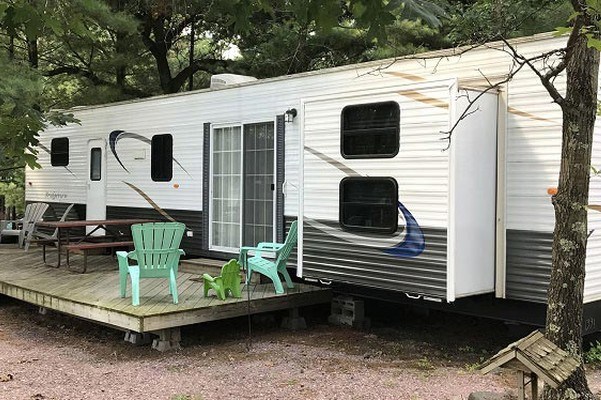
Permanent RV Setup: Setting Up a Travel Trailer Permanently
RVs can be like homes. Just take the wheels off and it is not going anywhere, just like a home doesn't go anywhere. The good thing about ‘permanently’ setting up a travel trailer is that after a few years you can reverse the foundation and move to a new location. A home takes more work to move.
Setting up a travel trailer permanently is also like choosing a home. You have to decide on which location will be the right spot for you and your spouse. The next key would be to make sure the ground is perfectly level. If it isn’t, you won’t be comfortable.
To learn more about setting up an RV or travel trailer permanently, just keep reading our article. It has the information you need to know about in order to get the job done correctly. RVs and travel trailers need the same basic key elements to work properly.
Setting Up a Permanent RV Site
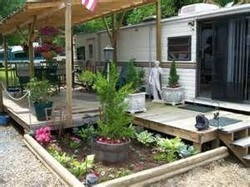
Some people enjoy the RV or travel trailer life. The main reason that they do is that they can pick up and move to a new location when they have exhausted all the fun things to do in their current place.
Then some have found the perfect spot and do not want to move from it. That is the time to think about setting up the travel trailer permanently. There are very good reasons why you should consider finding a perfect spot to live in.
One reason is that you only have to do this task once. With the constant moving around, you are setting up, leveling, and taking down every time you want to explore a new region of the country.
Another reason to set up a permanent travel trailer spot is that you have explored the country and now found the right spot where you want to spend your retirement. Whatever the reasons you have, setting up a permanent travel trailer site is a good idea.
You get a bit more stability, you can become part of the local community and it doesn’t take that much more work than setting up a site temporarily. There is something you should be wary of though, and you should check into this before you start all the work.
There are some counties, cities, or states that will level property taxes on your travel trailer if you remove the wheels. They will do it to RV owners who do the same thing. Keeping the wheel son and the travel trailer licensed avoids paying those taxes.
Check with the local authorities of the area or the campground owners you are setting up in to make sure. You never know what different regions will do when it comes to taxes.
How to Set Up a Travel Trailer Permanently
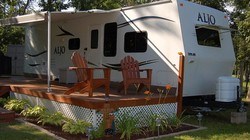
There are a few steps involved in this process and you should follow each step to make sure you get it right. Nothing is worse than a bad set-up as it makes permanent travel trailer life a lot more awkward than it should be.
Step 1. The decision
This is the most important part of the process as you have to decide where you want the travel trailer to remain permanently. If you are not happy with the area, you won’t stay that long so make sure you get the perfect spot for you and your spouse.
Step 2: Leveling
This is the next most important act you will do in this process. If the TT is not level you will have a hard time sleeping, cooking, and even relaxing. Also, toilets and other appliances may not work that well when the TT is not level to perfection.
That can lead to some uncomfortable situations including your food not staying fresh or cooking properly. Plus, you may get false indicator readings which will affect how you empty your tanks or refill them.
If you are going to be in an RV park, most concrete slabs have been installed by professionals who know how to get the pad level. You won’t have much to worry about on those pads.
However, if you go to a campground or apiece of raw land, leveling your TT will take a bit more work to get it right.
Step 3: The foundation
If you are going to a regular RV campground that allows permanent set-ups, then you do not have to worry about this step. The foundation is ready for you. You just have to supply the necessary equipment like cement blocks, 2 x6 or 2 x8, or whatever size wood you want along with stabilizers, leveling blocks, and wheel chocks.
If you are building your own permanent site, then you have to consider drainage issues, and making sure the ground is level while still being able to drain. Your foundation should include drainage rock, then some concrete patio stones some wood blocks.
What you eventually use will be up to you but it should protect the ground underneath your trailer. You can remove the tires if you want, which may alleviate leveling issues, and you can either store those tires or sell them if you plan on staying in one spot for more than 7 years.
Some people suggest removing the axles and selling them as well, but that seems to be an extreme measure unless you are never going to more the travel trailer again. How you do this stage of the process is again up to you just make sure to take into account the height the tires add to your positioning.
The battle is basically over once you have leveled the travel trailer. Everything else after that is minor in comparison to this one task.
How to Level Your Trailer
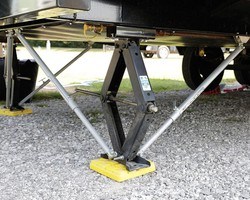
As we have said, this is the main priority when you want to have a permanent setup for your travel trailer. If the trailer is not level, nothing else matters as you will be encountering a lot of difficulties every day you live in the rig.
Some people say that using pressure-treated wood piers is a good leveling tool, but use them at your own risk as these pieces of lumber can still absorb water, rot, and split on you. When they do, it can be very difficult to replace them.
- Step 1: Once you have selected your permanent site, put a level on your TT to see how level it is and where you need to add some leveling equipment.
- Step 2: Use leveling blocks to help you get the tires in the right position. These leveling blocks are similar to the Lego toy. That means you can add to or subtract from them in order to get the right height for the tires.
When you move your trailer onto these leveling blocks, make sure to center the tires exactly. A little bit off-center may affect your level or it may help the tire deteriorate faster, making it unsafe to drive on if you decide to move.
- Step 3: Add the wheel chocks as these can prevent your tires from moving. If you want extra safety, then locking wheel chocks will be the better option. Also, go with the set that is on sale in your local RV or department stores. Professionally made wheel chocks are usually safer than DIY options.
- Step 4: Once those steps are done, lower your tongue jack till it is in the right position. A couple of pieces of wood measuring 2 x 10 inches in size should provide a stable surface to lower the tongue onto. Make sure to hit the pieces of wood dead center.
Or you can go with a plastic wheel dock or concrete patio stone if you are worried about rotting, splitting, and other issues that come with wood.
- Step 5: Use stabilizing jacks to help keep your travel trailer from moving during wind and other storms. These may already be installed in your trailer but if not, they are widely available. Just make sure to get the stabilizing jack that is strong enough to hold the weight of the travel trailer.
Some people confuse stabilizers with levelers and the latter term is what you are actually looking for. They will hold the weight of the corners with ease and help keep the travel trailer level.
5th Wheel Permanent Setup
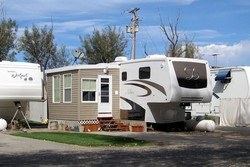
A lot of the previous instructions will work for the permanent set-up of a 5th wheel. However, you do not need to take the tires off or any weight off the tires. Most 5th wheels are set up to handle the weight.
Once you lower the jacks, you can block up the trailer and put some skirting on it to make it look nice. This will protect the wheels from the weather, which tends to age the rubber even as it sits still.
If you are blocking, then you may have to do a lot of shimmying to make sure everything fits into place. Some people raise the 5th wheel to take pressure off the tires and then lower the frame onto cinder blocks to reduce or eliminate any shaking.
Make sure to level the trailer using the onboard system first, then do any fine-tuning manually. Everyone has their own way of fine-tuning that meets their situation and makes sure the frame of the trailer does not get damaged.
RV Sewer Hookup Permanent
This is a necessary step when permanently setting up your travel trailer. The system pipes that come with your rig are often reinforced flexible plastic not meant for long-term use. They can wear out on you and you will end up replacing them more often when you are in a permanent situation.
- Step 1: Put a sewer adapter on the RV’s holding tank drains.
- Step 2: Measure the distance from the bottom of the adapter to the ground and subtract 2 inches. Cut that piece out and clear any burrs on the end using fine-grit sandpaper.
- Step 3: Add a 4-inch long section of 3-inch diameter rubber hose to the end of the sewer hose adapter. Use a hose clamp to attach this piece. Next, put a 3-inch diameter PVC elbow to the bottom of the vertical piece you cut out. There is no need to glue it together.
- Step 4: Cut a 6-inch piece of 3-inch diameter PVC pipe. Using the two-step PVC glue, place the 6-inch piece on the elbow and let it dry.
- Step 5: Cut a horizontal piece of PC pipe to the actual size you need.
- Step 6: Connect the pipe to the sewer drain and glue it into place. Make sure all connections are tight and fit together snugly as you do not want any leaks.
Permanent Camper Setup Tips
- 1. Check the air pressure in your tires to make sure they are at the right levels. Tires can lose air pressure fairly quickly.
- 2. Cover your wheels to protect them from the weather and help them last longer
- 3. Consider going solar when you are sitting permanently on a site. This will help reduce dependency on the grid
- 4. Have the best driver back your rig up onto the wheel levelers. That way you know the wheels will be centered on the levelers correctly
- 5. Check your hoses to make sure they can endure changes in temperatures. Insulate them to help protect them.
Some Final Words
Setting up a permanent location is not a bad idea. You get to enjoy the area you like the most and have a lot of stability. Plus, a permanent site can act as a nice getaway location when you need a break from the rat race.
Your travel trailer is always ready for you when you visit and you do not have to set it up every time you use it. Just make sure to protect the tires and other vital equipment.

